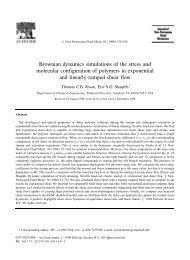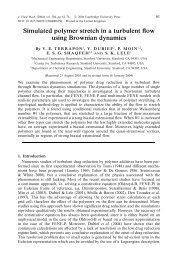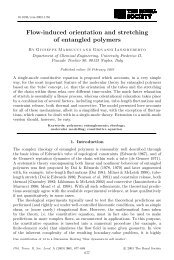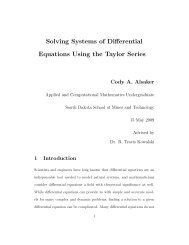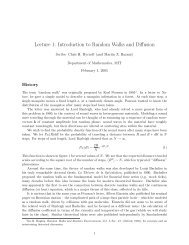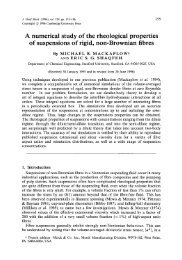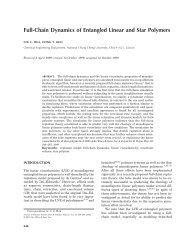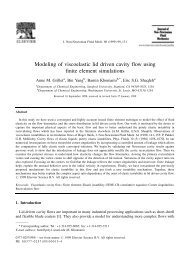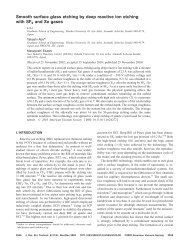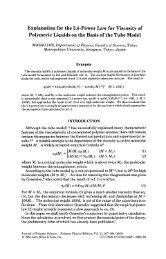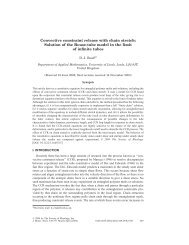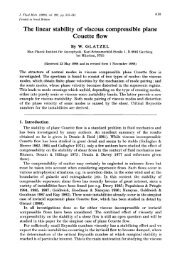Molecular modelling of entangled polymer fluids under flow The ...
Molecular modelling of entangled polymer fluids under flow The ...
Molecular modelling of entangled polymer fluids under flow The ...
You also want an ePaper? Increase the reach of your titles
YUMPU automatically turns print PDFs into web optimized ePapers that Google loves.
List <strong>of</strong> Figures<br />
1.1 Transient shear viscosity <strong>of</strong> a <strong>polymer</strong> melt at low shear rates compared<br />
to a perfectly viscous liquid and an ideal elastic solid. . . . . . . . . . . 3<br />
1.2 a) <strong>The</strong> storage and loss modulus for a single Maxwell mode with relaxation<br />
time τ. b) Linear rheology <strong>of</strong> a real <strong>polymer</strong> melt fitted with a<br />
spectrum <strong>of</strong> Maxwell modes [Venerus (2000)]. . . . . . . . . . . . . . . . 8<br />
1.3 Non-linear shear and uniaxial extension <strong>of</strong> an LDPE melt 1810H showing<br />
extension hardening (solid shapes) and shear thinning (open shapes)<br />
[Suneel et al. (Submitted)]. . . . . . . . . . . . . . . . . . . . . . . . . . 10<br />
2.1 Sketch <strong>of</strong> an N-step freely jointed random walk . . . . . . . . . . . . . . 13<br />
2.2 In a Gaussian random walk monomers which are well separated along<br />
the chain may come into close contact. . . . . . . . . . . . . . . . . . . . 14<br />
2.3 <strong>The</strong> derivation <strong>of</strong> a molecular expression for stress . . . . . . . . . . . . 17<br />
2.4 Scaling <strong>of</strong> linear viscosity <strong>of</strong> a range <strong>of</strong> linear <strong>polymer</strong> melts against X w<br />
which is proportional to molecular weight. <strong>The</strong> scaling switches from a<br />
slope <strong>of</strong> 1 to the 3.4 “law” for <strong>entangled</strong> <strong>polymer</strong> melts. From Berry and<br />
Fox (1968). . . . . . . . . . . . . . . . . . . . . . . . . . . . . . . . . . . 21<br />
2.5 <strong>The</strong> many body problem <strong>of</strong> an <strong>entangled</strong> melt (a) reduced to a single<br />
chain problem by replacing the individual entanglements with a confining<br />
tube (b). . . . . . . . . . . . . . . . . . . . . . . . . . . . . . . . . . . . . 22<br />
2.6 A chain in an entanglement network (narrow line) and its corresponding<br />
primitive path (broad line). . . . . . . . . . . . . . . . . . . . . . . . . . 23<br />
2.7 Relaxation <strong>of</strong> oriented tube segments by reptation after a step strain . . 24<br />
2.8 a) Dynamic modulus as calculated by the pure reptation model. b) Experimental<br />
storage modulus for a range <strong>of</strong> narrow distribution polystyrenes.<br />
Z ranges between ≈ 44 and ≈ 0.6 entanglements [Onogi et al. (1970)]. . 26<br />
2.9 <strong>The</strong>oretical predictions <strong>of</strong> relaxation after a step strain. [Reproduced<br />
from Doi and Edwards (1986)] . . . . . . . . . . . . . . . . . . . . . . . 28<br />
iv



